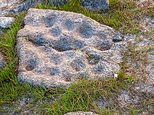
Low water levels brought on by the hot weather have uncovered prehistoric treasures in a reservoir in Cornwall.
Features known as cup-marked stones – made intentionally by ancient Britons – were re-discovered this month at Stithians Reservoir near Falmouth.
The mysterious markings are believed to date from at least the Bronze Age 4,000 years ago, but may originate in the Neolithic period predating it, meaning they could be more than 6,000 years old.
Photographs of the markings – taken last week – were posted on Twitter by local photographer Tim Pearson after the water levels in the reservoir dropped to 57 per cent of normal capacity. Further images were taken for MailOnline today.
In a sign of the impact the hot weather is having, this time last year the reservoir’s levels were at more than 80 per cent, according to data from South West Water.
The cup markings have appeared before when water levels have dropped in previous years, but this is the first time they have been seen in 2022.
Low water levels brought on by the hot weather have uncovered prehistoric treasures in a reservoir in Cornwall. Features known as cup-marked stones – made intentionally by ancient Britons – were re-discovered this week at Stithians Reservoir near Falmouth
The markings are believed to date from at least the Bronze Age 4,000 years ago, but may originate in the Neolithic period predating it, meaning they could be more than 6,000 years old
BRONZE AGE BRITAIN: A PERIOD OF TOOLS, POTS AND WEAPONS LASTING NEARLY 1,500 YEARS
The Bronze Age in Britain began around 2,500 BC and lasted for nearly 1,500 years.
It was a time when sophisticated bronze tools, pots and weapons were brought over from continental Europe.
Skulls uncovered from this period are vastly different from Stone Age skulls, which suggests this period of migration brought new ideas and new blood from overseas.
Bronze is made from 10 per cent tin and 90 per cent copper, both of which were in abundance at the time.
Crete appears to have been a centre of expansion for the bronze trade in Europe and weapons first came over from the Mycenaeans in southern Russia.
It is widely believed bronze first came to Britain with the Beaker people who lived about 4,500 years ago in the temperate zones of Europe.
They received their name from their distinctive bell-shaped beakers, decorated in horizontal zones by finely toothed stamps.
The decorated pots are almost ubiquitous across Europe, and could have been used as drinking vessels or ceremonious urns.
Believed to be originally from Spain, the Beaker folk soon spread into central and western Europe in their search for metals.
Textile production was also under way at the time and people wore wrap-around skirts, tunics and cloaks. Men were generally clean-shaven and had long hair.
This period was followed by the Iron Age which started around 650 BC and finished around 43 AD.
Archaeoastronomer Carolyn Kennett, who took her own images of the markings, told the BBC: ‘What’s interesting about the pre-history at Stithians is the amount of cup-marked stones. There are batches of them but they are really condensed together in a small area.
‘It is probably the most amount of cup-marked stones in one area in Cornwall, so it is the biggest amount of pre-historic rock art that we have
‘Cup-marking is definitely late or mid-Neolithic and into the Bronze Age they would still be doing it, but it is incredibly difficult to date these type of things.’
The markings are believed to have survived because of the fact they have largely remained underwater for so long.
Stithians Reservoir began operating in 1967 after a dam was built.
It meant that hundreds of acres of farm land, and some country houses, had to be submerged.
This month’s low water levels also exposed evidence of medieval farmsteads.
Before the area was flooded, the stones would have lain under a layer of top soil and vegetation.
It means that, by washing away the top soil, the water played a crucial role in their eventual discovery.
The cup-markings were first exposed in the early 1980s when water levels dropped sufficiently.
Flints and axes that were once wielded by ancient Britons were also found.
However, before the markings could be examined, the water levels rose again and so it was not until 1984 that they could be surveyed.
Cup-marked stones are also known to exist elsewhere in Britain, including beneath Cornwall’s Drift Reservoir, near Penzance.
They are common at other ancient sites around the world, but their purpose remains a mystery to experts.
One theory suggests that they are symbols made for the dead to help them in the after-life. Markings have been found elsewhere on the inside of tombs.
The markings may also have a wider religious, magical or astronomical significance.
Others have suggested that cup markings could have been made by Britons honing their stone-working skills.
The 5,000-year-old Cochno Stone in Scotland also boasts cup markings.
Discovered in 1887 by the Reverand James Harvey on a section of farmland near Clydebank in West Dunbartonshire, the Cochno Stone caused a sensation when it was unearthed.
The markings on the stone – it is covered in around 90 grooves and spirals – are far more elaborate than those on the stones at Stithians Reservoir.
In 2016, it was re-excavated so archaeologists could study it.
Photographs of the markings taken last week were posted on Twitter by local photographer Tim Pearson after the water levels in the reservoir dropped to 57 per cent of normal capacity
The cup markings have appeared before when water levels have dropped in previous years, but this is the first time they have been seen in 2022
The cup-markings were first exposed in the early 1980s when water levels dropped sufficiently. Above: Images of the stones taken for MailOnline today
Low water levels have uncovered prehistoric collection of cup-marked stones, pictured today at Stithians Reservoir
After it was discovered, the stone was vandalised and so was covered up again in 1965.
Photos taken before that show local people walking on the stone .
The water levels of Stithians Reservoir have dropped in recent weeks as Britain grapples with hot weather that reached its peak this week.
Water bosses have advised residents in some parts of the country to avoid baths, put less water in the kettle and only do full loads of laundry in a bid to avoid hose pipe bans as they grapple with increased demand and reduced reservoir levels.
This month’s low water levels also exposed evidence of medieval farmsteads. The area was flooded when the dam was built
One theory suggests that they are symbols made for the dead to help them in the after-life. Markings have been found elsewhere on the inside of tombs. Above: The markings today
An Environment Agency spokesperson said earlier this month: ‘People should use water wisely and follow advice from their suppliers.
‘Further hot, dry weather could put pressure on some areas. We will continue to take action where necessary.
‘River flows and reservoir levels have receded across central and south western England.’
The most recent fears of a hose pipe ban came in May 2020. It was the driest May in 124 years after only 1.25in (31.8mm) of rain fell in the month following an unusually dry and sunny April.
Stithians Reservoir is seen today after this month’s hot weather that has seen water levels plummet to 57 per cent of capacity
The reservoir pictured in July last year, when water levels were much higher. Stithians Reservoir began operating in 1967 after a dam was built. It meant that hundreds of acres of farm land, and some country houses, had to be submerged
Britain began the move from ‘hunter-gatherer’ to farming and settlements about 7,000 years ago as part of the ‘Neolithic Revolution’
The Neolithic Revolution was the world’s first verifiable revolution in agriculture.
It began in Britain between about 5000 BC and 4500 BC but spread across Europe from origins in Syria and Iraq between about 11000 BC and 9000 BC.
The period saw the widespread transition of many disparate human cultures from nomadic hunting and gathering practices to ones of farming and building small settlements.
Stonehenge, the most famous prehistoric structure in Europe, possibly the world, was built by Neolithic people, and later added to during the early Bronze Age
The revolution was responsible for turning small groups of travellers into settled communities who built villages and towns.
Some cultures used irrigation and made forest clearings to better their farming techniques.
Others stored food for times of hunger, and farming eventually created different roles and divisions of labour in societies as well as trading economies.
In the UK, the period was triggered by a huge migration or folk-movement from across the Channel.
The Neolithic Revolution saw humans in Britain move from groups of nomadic hunter-gatherers to settled communities. Some of the earliest monuments in Britain are Neolithic structures, including Silbury Hill in Wiltshire (pictured)
Today, prehistoric monuments in the UK span from the time of the Neolithic farmers to the invasion of the Romans in AD 43.
Many of them are looked after by English Heritage and range from standing stones to massive stone circles, and from burial mounds to hillforts.
Stonehenge, the most famous prehistoric structure in Europe, possibly the world, was built by Neolithic people, and later finished during the Bronze Age.
Neolithic structures were typically used for ceremonies, religious feasts and as centres for trade and social gatherings.
Source link
CHECK OUT: Top Travel Destinations
READ MORE: Travel News



